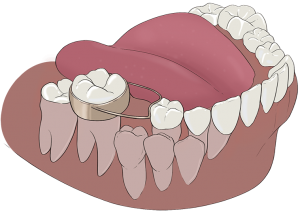
Even though your child will use baby teeth for chewing, they have another very important purpose. As you may be ware, primary teeth provide crucial guidance for permanent teeth. Therefore, when a baby tooth comes out too early, the adult tooth may drift, and eventually erupt in the wrong position. Aside from this, adjacent teeth may move into the gap and prevent the correct tooth from dropping into position.
If a primary tooth (baby or milk tooth), has to be removed early due to say, an abscess, or is knocked out in some kind of trauma, a space maintainer may be recommended to save the space. If the space is not preserved, the other teeth may drift causing difficult to treat crowding and orthodontic problems. If it is a front tooth then you don't need a space maintainer.
In each of these situations, space maintainers can be used to ensure that enough room is available for adult teeth to erupt.
Space maintainers are usually made from plastic or stainless steel. Some can be removed, while others will be cemented into the mouth. If your child needs a fixed space maintainer, a metal band will be put around teeth adjacent to the space that needs to remain open. Your child's dentist will them make an impression of the teeth in order to create the space maintainer. From there, the band and the models will be sent to a laboratory, where the retainer will be constructed. Once your dentist receives the space maintainer, he/she will cement it into your child's mouth. Depending on the resources at the dentist office, a space maintainer can be created and applied all in one visit.
As you may be aware, there are several different kinds of space maintainers. This includes:
Band-and-Loop Designs - a stainless steel band is placed around the crown of an adjacent tooth. A loop, or band is then attached to the band, and then stretched across the space that will remain open. The attachment will just touch the other side of the open space. Eventually, a permanent tooth will fill this space.
Lingual Arch Designs - a lower wire may be used when back teeth on both sides of the jaw are affected. Bands are wrapped around teeth on both sides of the mouth, as well as behind them. The band that creates the space is typically placed on the inside, or tongue side of the mouth, or along the bottom of the crown.
Distal Shoe Design - These space maintainers are placed under the gum. If your child looses a baby tooth that is in front of a molar that has not erupted yet. For example, if your child's six year molar has not erupted, it may be necessary to use this type of space maintainer. As may be expected, a distal shoe appliance will have to be monitored carefully. Unfortunately, erupting teeth can be blocked by this type of wire.
If several teeth are missing, your dentist my recommend using a partial denture. This includes situations where there is a genetic issue present. Among other things, children with ectodermal dysplasia may need to have a partial denture. Once a child with this condition reaches adulthood, he/she may also need implants or bridges to take the place of permanent teeth.

